Casco Bay Island Accessible Exploration
Explore the seafloor
Come for a dive at Casco Bay Island! Let images and videos introduce you to some of the amazing species that live here. Find out about the work that Peter Lawton's team do. Once you're back on the surface, learn about the camera and video technology that helps us study the seabed.-
Horse Mussel Bed
Horse mussels Modiolus modiolus are very dense in some parts of the Quoddy Region. These beds are important habitats. The mussel’s byssus threads stabilise sand and mud seabeds. Their shells provide shelter or attachment points for many animal and seaweed species.View species

(Photo: Peter Lawton, Fisheries and Oceans Canada)

-
Mixed Seabed
The northern red anemone is the most common anemone species in the Quoddy Region. Individuals can be up to 20 centimetres in diameter and are thought to be able to live for over 50 years.View species
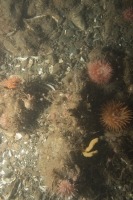
(Photo: Peter Lawton, Fisheries and Oceans Canada)

-
Bedrock
Northern sea stars Asterias rubens can grow to over 50 centimetres in diameter. The largest ones are usually found in areas where their prey is abundant, such as horse mussels beds.View species
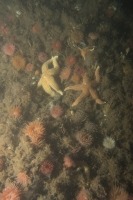
(Photo: Peter Lawton, Fisheries and Ocean Canada)

-
Horse Mussel Bed
Densities of up to 158 horse mussels per square metre have been recorded in the Bay of Fundy. Horse mussel beds provide shelter, nurseries for young, and feeding grounds for many species, including commercially important species such as scallops. Bottom trawling can damage beds and they can take many years to reform.View species
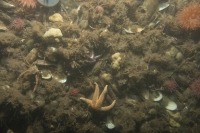
(Photo: Peter Lawton, Fisheries and Oceans Canada)

-
Sea Potato Forest
The sea potato Boltenia ovifera is a stalked sea squirt. It is associated with areas with strong tidal currents and is very common in the tide-swept channels of the Quoddy Region. Numbers have declined significantly in the Bay of Fundy in recent years. Sea potatoes can be seriously damaged by bottom fishing.View species

(Photo: Peter Lawton, Fisheries and Oceans Canada)

-
Encrusting Sponge
It is not always possible to identify all animals to species level from appearance. We can tell this is an encrusting sponge but if we want to know the species we need to take a sample and look at its skeleton using a microscope. In photographic surveys it is not usually possible to take samples. So scientists can identify many sponges only to phylum: ‘Porifera’. This means the true biodiversity of areas can be underestimated.
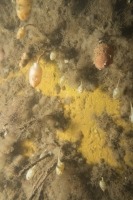
(Photo: Peter Lawton, Fisheries and Oceans Canada)

-
Mixed Seabed
On gravel and sand seabeds the Atlantic deep-sea scallop Placopecten magellanicus is often found. People fish this species commercially using drags. These are bags made of metal rings which boats tow over the seabed to scoop up the scallops. Drags can capture or damage other seabed dwelling species.View species
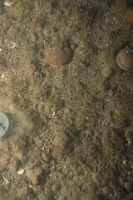
(Photo: Peter Lawton, Fisheries and Oceans Canada)

-
Rocky Seabed
Video Description:A lead weight, dangling from the frame of the drop camera, travels sideways over a rocky seabed. It brushes the tops of dense patches of sea potato sea squirts and bounces off boulders. Many northern red anemones are dotted over the seabed. Occasionally we see a flash of light as the camera takes a photograph. The weight that is suspended from the frame of the camera is visible. When this touches the seabed the cable on the weight becomes slack. This then triggers the camera to take a still image. This video has no sound.
-
Black & White Survey Footage
Video Description: This black and white underwater video was taken by Peter Lawton’s team in 2002. It was actually taken slightly south of this area in Curry Cove, Campobello Island. We see the frame of the video camera bouncing over the sea bed. It is hard to make out much detail on the seabed but we can see large northern sea stars, northern red anemones, occasional sea potatoes and branching sponges. For this camera system a scientist managed the cable that kept the camera at the right distance from the seabed by hand. They let down or pulled up cable, estimating how much from looking at a small video monitor. It could be hard for them to see this clearly as they were often working in bright sunlight on the deck so the footage is less smooth than on more automated systems. This video has no sound.
-
Rocky Seabed with Acadian Redfish
Video Description: In this underwater video we see a boulder seabed with occasional bright yellow sponges and sea squirts. An orange acadian redfish fish is visible at the base of one boulder. The camera zooms in on the fish. We can see it has a very large eye and dark markings on its body, together with the shape of its fins, these characters help the scientists to identify it. We can see numbers at the top of the video screen. These indicate the time and the geographical position. The red lasers visible on the video are 10 centimetres apart and provide a scale to measure organisms against. Scientists control the camera from the ship and are able to change zoom in on interesting species. This video has no sound.View species
-
SCUBA Diver & Bedrock Wall
A SCUBA diver took this video in 1992. This was part of a series of diving surveys led by Peter Lawton. The work was funded by Fisheries and Oceans and the Province of New Brunswick. The aim was to identify sensitive coastal areas for invertebrate fisheries. This was in connection with the major phase of aquaculture development in south-west New Brunswick. Video Description: A SCUBA diver descends down the steep wall of Casco Bay Island through green tinged water. He passes through a forest of sea potatoes. Under an overhanging ledge a wolffish peers out from its den. The camera zooms in on the wolffish's mouth letting us see its jagged teeth. This video has no sound.
-
Travelling on 'Seawolf'
Video Description: We travel with Peter Lawton and his team out to their dive site on the ‘Seawolf’. ’Seawolf’ is a grey, 8 metre long, RHIB (Rigid Hulled Inflatable Boat). The trip is bumpy, travelling at speeds of up to 46 kilometres per hour, ‘Seawolf’ bounces over the crest of waves. Peter’s team sit on special vibration reducing seats and wear protective helmets. We hear the roar of the engines. Spray splashes over the boat's sides as it crashes through the waves.Learn more
-
Lobster Walking
Video Description: We follow a lobster as it slowly walks over a rocky seabed. Despite the fact that the depth is only 15 metres, there is little natural light and it is flood lit by the camera’s bright LED lights. The lobster marches past pink-heart hydroids, green sea urchins, sea potatoes and a northern red anemone. An Atlantic rock crab scuttles out of its path. This video has no sound.View species
-
Bedrock with Anemones
Rock seabed is important habitat for many species. Some like the northern red anemone grow on top of it. Others, such as lobsters are found hiding in crevices in bedrock and between boulders.View species
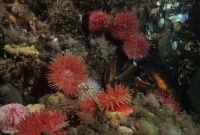
(Photo: Connie Bishop)

-
Bedrock Community
The sea vase Ciona intestinalis is not native to Canada and was first introduced to New Brunswick in 1852. It is becoming very common in the Bay of Fundy. It can cause problems for native species and industries like aquaculture.View species
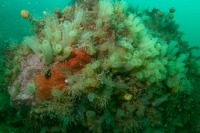
(Photo: Claire Goodwin)

-
Bedrock with Green Urchins
The green sea urchin Strongylocentrotus droebachiensis is very common around Casco Bay Island. If sea urchins become too abundant they can create areas with no seaweed. These are known as urchin barrens. But if there aren’t enough urchins, seaweed may become over-abundant. It is important to manage pressures as far as possible to keep the ecosystem balanced.View species
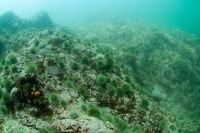
(Photo: Claire Goodwin)

-
Sea Potato Forest
Sea potatoes Boltenia ovifera are stalked sea squirts. They are very common around Casco and in other tide-swept areas of the Quoddy region.View species
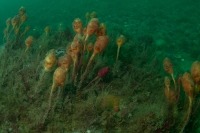
(Photo: Claire Goodwin)

-
Sea Raven
Video Description: A sea raven slowly swims over a seabed of sand and small boulders. We can hear the exhalations of the diver filming the fish in the background. As the camera zooms in we can see its large pectoral fins, fringed mouth and large rays of its dorsal fin. The branched fleshy tabs under its jaw help us distinguish it from other fish species. Several rows of sharp teeth arm its wide mouth. It is a voracious predator, feeding on many species of fish and invertebrates. It is well camouflaged on the sea bed - looking rather like a seaweed-covered rock. It waits for prey to approach then lunges.View species
-
Reviewing Video
Peter Lawton and a student Callum Mireault review live images onboard the Viola M. Davidson. They are monitoring the camera on the seabed. The boat is position to take advantage of tide and wind conditions to drift across underwater locations of interest. The science team make adjustments including starting and stopping recording of the video feed.

(Photo: Fisheries and Oceans Canada)

-
The ‘Viola M. Davidson’
The larger cameras used in deep water need a boat with a crane to lower them to the seabed. For this work Peter uses the 18 metre long Canadian Coastguard vessel ‘Viola M. Davidson’.

(Photo: Fisheries and Oceans Canada)

-
Peter Lawton Prepares to Dive
Fisheries and Oceans Canada researcher Peter Lawton and dive buddy Monica Finley prepare for a survey dive from the ‘Seawolf’. The seawater can range from 2-14°C, depending on the time of year. The divers wear drysuits, thermal layers and thick neoprene hoods and gloves to keep them warm.
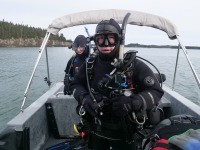
(Photo: Fisheries and Oceans Canada)

Cameras
These are camera systems that Peter Lawton's team have used for their work.-
Coastal Drop Camera System
This system has been in operation since 2014. It was co-developed by Peter Lawton, DFO ocean technologists (Kelly Bentham, Kirk Phelan, Robert Benjamin) and graduate student Callum Mireault. It can record both high definition and ultrahigh definition imagery. It has a digital still camera as well as a video camera. The two cameras are housed in a rectangular frame which also contains video lights and flashes for the still camera. It also has a system for determining where the camera frame is on the seabed in relation to the surface vessel. The video camera is a Blackmagic Production 4K video camera. It is housed in a waterproof Nauticam housing and attached onto the frame.Learn more
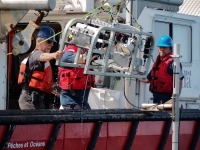
(Photo: Fisheries and Oceans Canada)

-
Urchin 1 Drop Camera System
This system was used by Peter Lawton’s team between 2001 and 2005. It was co-developed by Peter and Michael Strong. It has a small frame which holds a black and white standard definition camera which could operate in low light. “Pencil” style laser pointers were attached on either side of small back fin. These were set up manually to appear at a particular point in the image screen.Learn more

(Photo: Fisheries and Oceans Canada.)

-
Urchin 2 Drop Camera System
This system was used by Peter Lawton’s team between 2006 and 2007. It was co-developed by Peter and Michael Strong. The frame held the camera stable off the seabed when it is dropped. The fin helped orientate it against the current. The camera was a standard definition colour video camera in a titanium housing. The camera was placed on the frame so that the glass dome housing the camera faced directly downward. The camera was able to pan (rotate) 360 degrees and also tilt 180 degrees, as well as zoom in to 10x the wide angle view. A pair of lasers were situated on the top circular frame pointing directly down on the seabed. They were 10 centimetres apart, but only seen when the camera was also pointed directly down. The system was nicknamed M2P2 – after the basic form of the camera (and Star Wars’ R2D2).Learn more
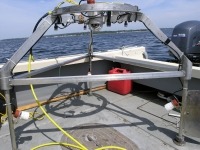
(Photo: Fisheries and Oceans Canada)

-
SONY V101 camcorder
This standard definition colour video camera was housed in a waterproof Amphibico underwater housing. It was used between 1990 and 2000. Video was recorded on Hi 8 millimetre video tape. Underwater it was used with Amphibico video lights.Learn more
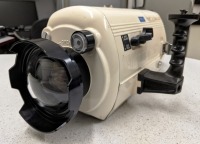
(Photo: Fisheries and Oceans Canada)

-
GoPro Hero Action Camera
The GoPro Hero Action Camera series are capable of capturing up to ultra-high definition video plus 11 megapixel photos. In their GoPro housing they are waterproof to 60 metres. This camera weighs around 140 grammes and is less than six centimetres maximum width. It can be mounted on people and equipment to capture action footage.Learn more
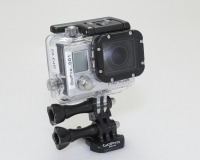
(Photo: Fisheries and Oceans Canada)

-
Blackmagic 4K Video Camera (Setup for SCUBA)
The video camera is a Blackmagic Production 4K video camera. It is housed in a waterproof Nauticam housing. It can capture ultra-high definition video imagery on an internal disk drive. It is used with Big Blue LED video lights which can illuminate a wide area of the seabed.Learn more
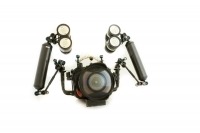
(Photo: Fisheries and Oceans Canada)

-
Housed Compact Camera
This set up belongs to SCUBA instructor Connie Bishop of COJO diving. An Olympus TG-6 is housed in a polycarbonate Ikelite housing. The TG-6 is a compact, rugged camera which is waterproof to 15 metres. It has a 12 megapixel sensor. Video can be captured at 4K. Connie has one camera system set up for wide angle shots with a dome port and one just for macro. She lights her images with two Ikelite DS51 strobes. This sort of system is used by many recreational divers.Learn more
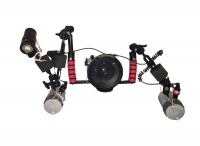
(Photo: Connie Bishop)

-
Housed Digital SLR Camera
This is a digital SLR camera (Nikon D500) in an Aquatica waterproof housing. It is operated by a SCUBA diver. It can take both high quality digital images and video. The dome port in the front is used with a Tokina 10-17 millimetre wide angle lens. With this lens the diver can take wide angle habitat shots while close to the subject. This makes them easier to light. Two powerful Ikelite strobes are used to provide lighting.Learn more
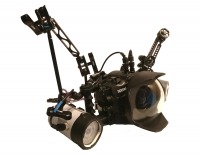
(Photo: Claire Goodwin)


